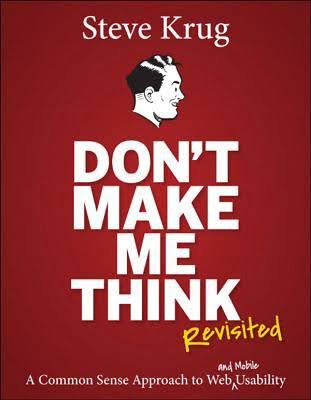Book Review - Don't make me think

TL;DR
An easy-to-read book with a wide target audience covering the core aspects of web usability, describing the complete process of usability testing and providing stimulation for further reading.
Why this book?
Steve Krug’s Don’t make me think (Revisited) is among the most popular books regarding web usability. It has been on my to-read list for quite some time. After reading Steve Job’s biography*, it was simply the only book I could think of as my next read.
General Feeling
I will start with its size (approximately 200 pages) which is a huge plus for me since I generally do not like long books. If we now proceed to the book’s content, it is absolutely obvious that the author generally knows what usability means since he wrote a really usable book!
It is easy to read without getting tiring at any point. It uses a lot of tables, diagrams and pictures in order to visualize a lot of information making the whole reading experience really pleasant.
Structure
The flow of the book is easy to follow. It is divided into four sections covering:
- The basic guiding usability principles according to the user’s usual behavior and expectations.
- The things that definitely have to be done right when creating a web site like navigation and right positioning of information within the page.
- Usability Testing by describing the complete process.
- Mobile usability, accessibility and ways of convincing upper management to invest in usability testing.
What I think…
As said earlier, this book is a nice read. It talks about and analyzes aspects of web design and usability that people often miss or neglect despite the fact that they are so obvious. I have already found some improvements that can be done in this blog as well.
It also talks you through the process of usability testing and how you can do it with minimal cost without having to outsource it. This might be extremely useful for companies with limited financial resources like startups.
The only part of the book that did not come up to my expectations was the mobile usability chapter which was really short and only scratched the surface of the topic.
To sum up, in my humble opinion, the book’s main goal is to give you an overview of web usability and the basic rules that have to be followed in order to have an acceptably usable web site. The author keeps stimulating the reader and recommending books for digging deeper into specific aspects of usability.
Who should read it?
The beauty of this book is that, thanks to the way it was written, has a really wide target audience like product managers, web designers and developers. Therefore, anyone professionally involved in UI development from any position and anyone with an affinity for user interface design and usability would definitely benefit from reading this book.
*Usability and perfect user experience were two of the core passions of Steve Jobs throughout his life and also two of the core characteristics of all the products he introduced.